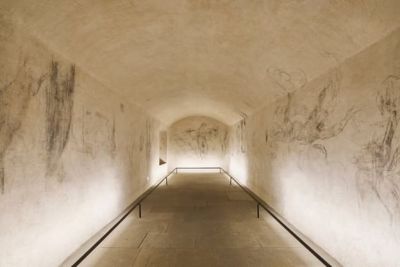The room where Michelangelo hid from Pope Clement VII in 1530, whose walls are covered with his etchings, opened to the public last month. Sketches drawn on the walls of a small room in Florence by Renaissance artist Michelangelo as he hid from an angry pope are going on show for the first time. Charcoal figures run along the sides of the room, a former coal cellar in the depths of the Museum of the Medici Chapels. Known as Michelangelo's "secret room", the space, which measures 33 feet by 10 feet, was used to store coal until 1955. It was then "unused, sealed and forgotten for decades below a trapdoor covered by wardrobes, furniture and stacked furnishings" before being discovered again in 1975, the museum said in a statement. The director at the time, Paolo Dal Poggetto, attributed many of the sketches uncovered to Michelangelo Buonarroti, best known for his statue of David and the frescos in the Vatican's Sistine Chapel. Dal Poggetto believed Michelangelo had hidden from Pope Clement VII in the room for two months in 1530 because the pontiff, a member of the Medici family, was "infuriated" with him. The artist had served as a supervisor of the city's fortifications during the short-lived republican government (1527 to 1530), when the Medici were driven out of the city. "The drawings, still being studied by critics, were produced during the artist's 'self-confinement' period, using the walls of the small room to 'sketch out' some of his projects," the museum said.
La sala in cui Michelangelo si nascose da papa Clemente VII a Firenze nel 1530 è stata aperta al pubblico il mese scorso per la prima volta. La stanza contiene ancora tutti gli scarabocchi di Michelangelo. L'artista dovette nascondersi dal Papa perché il Papa fu parte della famiglia dei Medici. A quel tempo, papa Clemente si arrabbiò con Michelangelo perché la famiglia Medici dovette lasciare Firenze, e Michelangelo fece parte del governo republico durante questo tempo (dal 1527 al 1530). La stanza fu parte di una cantina del Museo del Cappello Medici. La “Stanza Segreta” di Michelangelo misura solo 10 metri per 3 metri. Fino al 1955, la sala fu utilizzata come uno sgabuzzino per il carbone. Dopo quest'anno la stanza, nascosta con una botola, non fu più utilizzata e sopra la botola si trovavano gli armadi e i mobili. Secondo il museo, la stanza è stata riscoperta e gli scarabocchi di Michelangelo erano ancora in buone condizioni. Il direttore del museo, Paolo Dal Progetto, ha detto che i visitatori del museo possono vedere gli scarabocchi di Michelangelo su tutte le pareti. Michelangelo, noto per la statua del David e la Cappella Sistina, è ancora oggi considerato uno degli artisti di maggior successo di tutta la storia artistica italiana.



